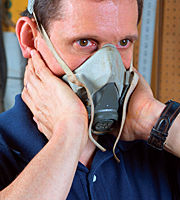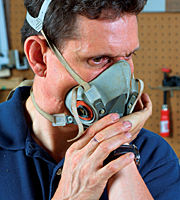| Page 2 |

|
|
1 - Personal Protective Equipment
2 - Page 2 |

Safety Officer or Collaterial Duty Safety Officer will determine if the use of a respirator is necessary for the appropriate work operation. This may be evaluated by one or a combination of the following method:
- Consultation with the Supervisor
- Interviewing the employee
- Observing the work operation
- Collecting air samples during the work process to assess airborne exposure to any toxic material. Respirator will be required for all operations where the atmospheric concentration is in excess of the limits specified by the Occupational Safety and Health Administration.
- Evaluating existing or alternate engineering controls.
Medical Approval
Obtain and complete Occupational Medical Surveillance Form for medical approval to wear respiratory protection. The medical examination will assessed at the contracted health care provider.
Respiratory Protection Training
Fitting of the respirator will be done either by the University's Environmental Health & Safety Department, or the local Safety Officer, or your Supervisor, depending upon the situation.
Repirator User's Responsibilities
- Update your respirator qualification status annually
- Reschedule for a future date if you cannot attend your scheduled appointments
- Inform your supervisor of any personal health problems that are or could be aggravated with the use of respiratory equipment
Disposable masks can be worn for dusts from grinding, crushing and the general processing of coal, cotton, flour, and wood, and mists from sprays that do not produce harmful vapors.
Disposable masks cannot be used for:
- Fumes, gases, vapors, asbestos, sandblastinng, or paint spray
- Concentrations of contaminants which are unknown or are immediately dangerous to life
- Concentrations of dusts and mists which exceed the maximum use concentration or 10 times the PEL, whichever is lower
Fitting Instructions
- Hold respirator in hand, allowing headstraps to fall below hand.
- Place respirator under chin with nosepiece up.
- Stretch top strap to crown of head. Pull bottom strap over head, below ears, to around neck. Adjust respirators for comfortable fit.
- When applicable, place fingertips from both hands at the top of the metal nosepiece and mold to the shape of nose by pushing inward while moving your fingertips down both sides of the nosepiece. Note: Pinching the nosepiece with one hand may cause a bad fit and result in less effective performance. Use two hands.
- Each time you enter the contaminated area the seal of the mask should be fit checked. Cover front of respirator by cupping both hands and inhale sharply. A slight negative pressure should be felt inside respirator. If leakage is detected at respirator edges, adjust straps by pulling back along the sides and/or reposition respirator. Repeat until sealed properly.
Half-mask respirators are the most widely used types of respirators. Each half-mask face piece is equipped with cartridges which purify the air as the wearer breathes. Different types of cartridges are available for filtering various air contaminants. For example, HEPA cartridges protect against low concentrations of radioactive and toxic particulate.
Limitations Since this type of respirator does not supply air, it cannot be used in oxygen-deficient atmospheres or IDLH atmospheres. It can only be used for protection against the contaminants listed on the cartridge. It cannot be used against natural gas or vapors with poor olfactory warning properties. The wearer should leave an area immediately if the smell of gas or vapor is detected inside the mask or if the breathing resistance increases. The half-mask respirator shall not be worn when facial hair extends under the face-mask sealing area.
Procedure - To put on and adjust a half-mask:
|
- Use the mask approved for use, as specified during the fitting session
- Hold the mask so the narrow nose-cup points upward
- Grasp both lower mask straps and hook them behind the neck and place the top cradle straps on the top and behind the head
- Adjust the straps so the fit is snug but comfortable
- Check for leaks when possible by covering the filter inlet opening with the palms of the hands and inhaling gently. If the mask pulls in toward the face, the fit is good. This is known as a negative pressure fit check.
- Check for leaks when possible by covering the exhalation valve and blowing out gently. The mask should hold a slight positive pressure. This is known as a positive pressure fit check.
Full face-mask respirators provide more protection than half-masks because their shape allows a better mask-to-face seal. They also protect the eyes from irritating chemicals or particulate atmospheres.
Full face-masks come equipped with selective types of air-purifying canisters/cartridges, dependent upon the protection required. Additionally, full face-masks are available with air-supplied systems such as air lines or SCBA (Self Containing Breathing Apparatus) units. Special arrangements must be coordinated with outside vendors or contractors if this type of protection is required.
Limitations- Air-purifying full face-masks have the same limitations for use as half-mask respirators. Additionally, standard eyeglasses interfere with the mask-to-face seal; therefore, respirator wearers should obtain an additional pair of glasses through their department for installation into a mask. Limitations for use of full face mask with air-supplied systems is covered under subsection 4.15 on SCBA.
Procedure - To put on a full face-mask:
- Loosen all straps, pull the harness over the head, and place the chin in the chin cup
- Pull the head harness well down on the back of the head
- Tighten the harness gently, starting with the bottom straps and then the middle and top straps

- Check the fit by closing off the air hose or canister opening with the palm of the hand and inhaling gently. The user should then hold his/her breath for a few seconds. A good fit is indicated if the mask remains collasped toward the face during this time.
- A positive fit check should also be conducted
Store the respirator at the end of each shift to protect it from dust, sunlight, heat, extreme cold, excessive moisture, and chemicals.
 Quiz for Respiratory Protection
Quiz for Respiratory Protection
| << Previous 1 [2] |


